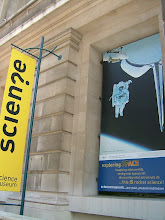ScienceNOW Daily News
22 August 2008
The popular conception of black holes is that they obliterate anything in their path, including time, space, and matter. Stars can escape annihilation if their orbits keep them far enough away. But some stars not only orbit perilously close to a supermassive black hole but also appear to have formed in its vicinity. Earlier in this decade, for example, astronomers spotted a population of very young--under 10 million years old--and very massive stars locked in elliptical orbits around the Milky Way's central black hole (ScienceNOW, 13 October 2005).
Could the stars have migrated there? Not likely. They're too young, and there are no nearby star hatcheries that could have produced them. The other possibility is that the stars formed in place. But astronomers also considered that idea unlikely, because the supermassive black hole would have shredded any cloud of gas--from which all stars condense--pulled into its influence.
Now the homegrown scenario seems more realistic, thanks to a computer model developed by astrophysicists Ian Bonnell of the University of St. Andrews in Fife, U.K., and Kenneth Rice of the University of Edinburgh, U.K. The simulation, which required more than a year of supercomputer time, tracked two hypothetical clouds of molecular hydrogen--the basic stellar building material--moving within a light-year or so of a supermassive black hole, much like the one anchoring the Milky Way. The researchers report today in Science that as the clouds fell toward the black hole, its gravity disrupted but did not destroy their clumpy structure. Eventually, the clouds flattened and merged into a disk that followed an elliptical orbit. During the flattening, nearly 200 new stars ignited, within a few hundred thousand years. Nearly all the resulting stars were very massive, meaning that they will live short and violent lives ending in supernovae.
The findings raise the question of where the star-forming clouds in the Milky Way would have come from. Bonnell and Rice speculate that they drifted freely within the galaxy until interaction with some other object or objects, such as larger clouds or other black holes, sent them hurtling toward the supermassive central black hole. But the answer remains unclear.
The simulation is a "breakthrough," says astronomer Mark Voit of Michigan State University in East Lansing, because it helps explain why those massive young stars around the Milky Way's center follow such elongated orbits. It "addresses one of the big open questions in astrophysics," adds Volker Bromm, an astrophysicist at the University of Texas, Austin. Thanks to this work, he says, "one wonders what the next-generation telescopes will find in the far-away universe just a few years from now."
From: http://sciencenow.sciencemag.org/cgi/content/full/2008/822/2?etoc









沒有留言:
張貼留言